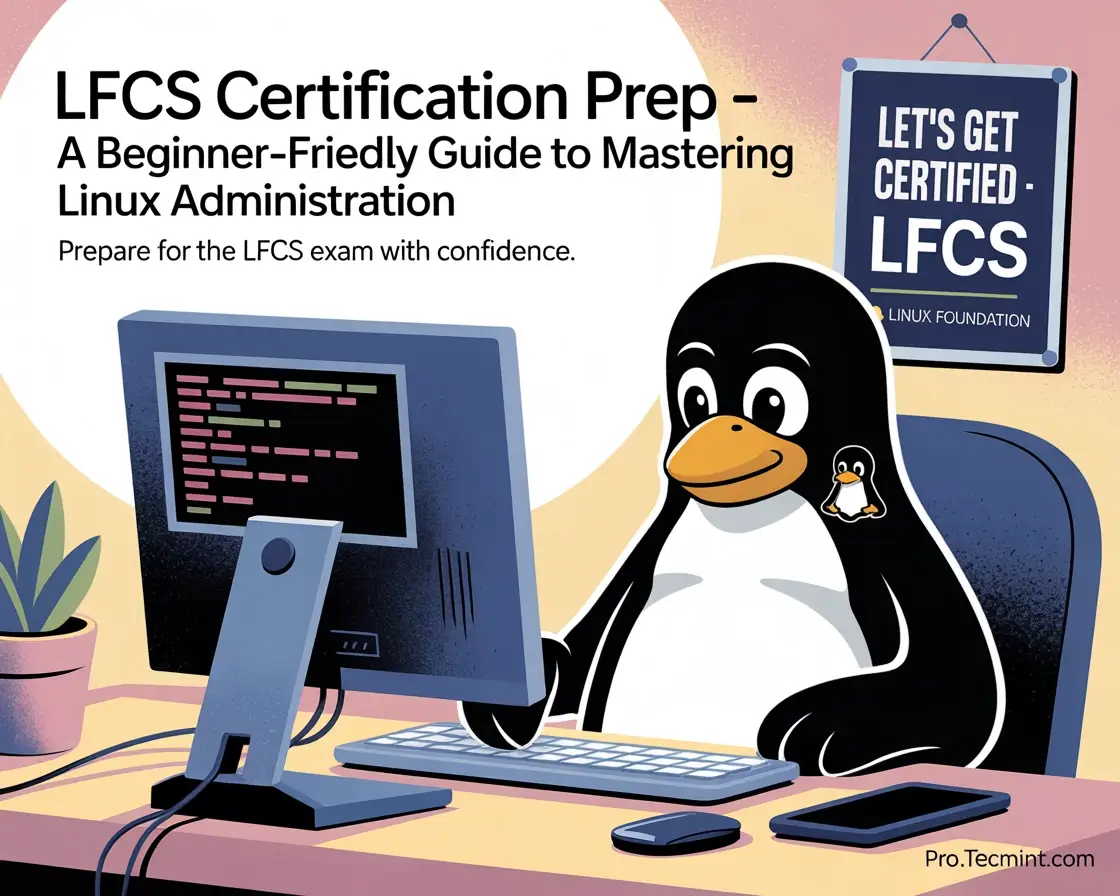Introducing The LFCS Certification Preparation eBook
A complete, beginner-friendly guide with 34 hands-on chapters designed to help you master Linux system administration, networking, storage, security, and everything you need to pass the LFCS certification exam.
— Tecmint Pro — Website

The Linux Foundation Certified System Administrator (LFCS) certification is one of the most respected entry-level Linux certifications in the IT world, which is designed to validate your ability to manage Linux systems in real production environments, from configuring networks and managing users to handling storage, processes, and security.
Preparing for the LFCS exam can be overwhelming, especially if you’re unsure what topics to study or how to practice effectively.
That’s exactly why we created this comprehensive guide:
“LFCS Certification Preparation Guide for Beginners”
🧾 eBook Overview
Title: Introducing The LFCS Certification Preparation eBook
Length: 375 Pages
Chapters: 34
Skill Level: Beginner to Intermediate
Format: PDF (Instant Download)
Last Updated: October 2025
🎯 Why LFCS Is a Smart Career Move
The LFCS certification proves that you can handle essential system administration tasks across any major Linux distribution, whether it’s Ubuntu, CentOS, openSUSE, Debian, or others.
By earning the LFCS certification, you're proving to employers that you can:
✅ Configure and manage Linux systems like a pro.
✅ Set up and troubleshoot networks, services, and firewalls.
✅ Work confidently with users, permissions, and security tools.
✅ Handle storage management (LVM, RAID, partitions, swap, etc.).
✅ Automate basic tasks using shell scripts.
✅ Manage system processes, services, and logs.
✅ Secure systems using SELinux, AppArmor, and encrypted filesystems.
With Linux powering 90% of cloud servers, containers, and enterprise systems, LFCS skills open doors to careers in DevOps, cloud administration, cybersecurity, and system engineering.
📘 What You’ll Learn in This Course
This book is your practical guide to learning Linux system administration. Each chapter has easy examples, exam tips, and troubleshooting steps so you can practice like you’re working on a real Linux system.
Here’s a quick breakdown of what’s covered across 34 in-depth chapters:
- Chapter #1: Linux I/O Streams, Redirection, and Text Processing
- Chapter #2: Mastering Vi/Vim Command-Line Text Editor
- Chapter #3: Learn to Archive, Compress, and Manage File Permissions in Linux
- Chapter #4: How to Partition Disks, Format Filesystems, and Set Up Swap in Linux
- Chapter #5: Mount and Unmount Filesystems in Linux
- Chapter #6: How to Set Up Software RAID and Backups on Linux
- Chapter #7: Understanding Linux Boot and Startup Services
- Chapter #8: Managing Users, Groups, Permissions, and PAM Security
- Chapter #9: Understanding Package Management in Linux
- Chapter #10: Understanding Terminals, Shells, and Basic Shell Scripting
- Chapter #11: Create, Resize & Mount LVM Volumes in Linux
- Chapter #12: How to Use man, info, and help Commands in Linux
- Chapter #13: The Grand Unified Bootloader (GRUB)
- Chapter #14: Monitor CPU, Processes, and Resource Limits in Linux
- Chapter #15: Manage Kernel Runtime Parameters in Linux
- Chapter #16: How SELinux and AppArmor Improve Linux Security
- Chapter #17: Linux Access Control Lists (ACLs) and Disk Quotas
- Chapter #18: Setting Up Network Services in Linux
- Chapter #19: How to Set Up an FTP Server on Linux
- Chapter #20: Setting Up a Caching DNS Server
- Chapter #21: Installing and Configuring a MariaDB Server
- Chapter #22: Configuring an NFS Server
- Chapter #23: The Apache Web Server
- Chapter #24: The Firewall - iptables, ufw, and firewalld
- Chapter #25: Static and Dynamic Routing
- Chapter #26: Encrypted Filesystems and Swap Space
- Chapter #27: System Usage, Utilization, and Troubleshooting
- Chapter #28: Setting Up a Network Repository on RHEL
- Chapter #29: Setting Up a Network Repository on Ubuntu
- Chapter #30: Network Performance, Security, and Troubleshooting
- Chapter #31: Managing and Configuring VMs and Containers
- Chapter #32: Learn Git and GitHub Basics
- Chapter #33: Configure IPv4 and IPv6 Networking
- Chapter #34: Configure Bonding and Bridge Devices
🔓 How to Get This eBook
You have two simple ways to get the Introducing The LFCS Certification Preparation eBook:
Option 1: Subscribe to Tecmint Pro
Subscribe and get this eBook plus 8 others (Master Linux in Just 7 Days, RHCSA, RHCE, Bash Scripting for Beginners, and more), with all future updates and full access to:
- Ad-free access to all regular and premium articles
- Premium guides, tutorials, and full Linux courses (Bash scripting, system administration, DevOps, containers, cloud, security & more)
- Downloadable PDFs, cheat sheets, and offline resources
- All 8 exclusive Linux eBooks (instant download – worth $200)
- Certification resources for RHCSA, RHCE & LFCS, and more
- Hands-on content for Docker, Kubernetes, Ansible, Terraform, CI/CD pipelines
- Security hardening and cloud-infrastructure best practices
- AI tools & integrations tailored for Linux professionals
- Weekly newsletter with fresh Linux tips, tools, and command guides
- Priority comment support for fast expert help
- Lifetime updates to every resource (Root Plan only)
You can download this eBook and all others anytime from the Download Center.
Option 2: Buy the eBook for $19.99
Just want the book without a subscription? No problem, get the current version as a one-time purchase.
📖 Prefer Online Reading?
If you’re a Tecmint Pro subscriber, you can read this course directly on our website, perfect for those who prefer following chapters online, step by step.